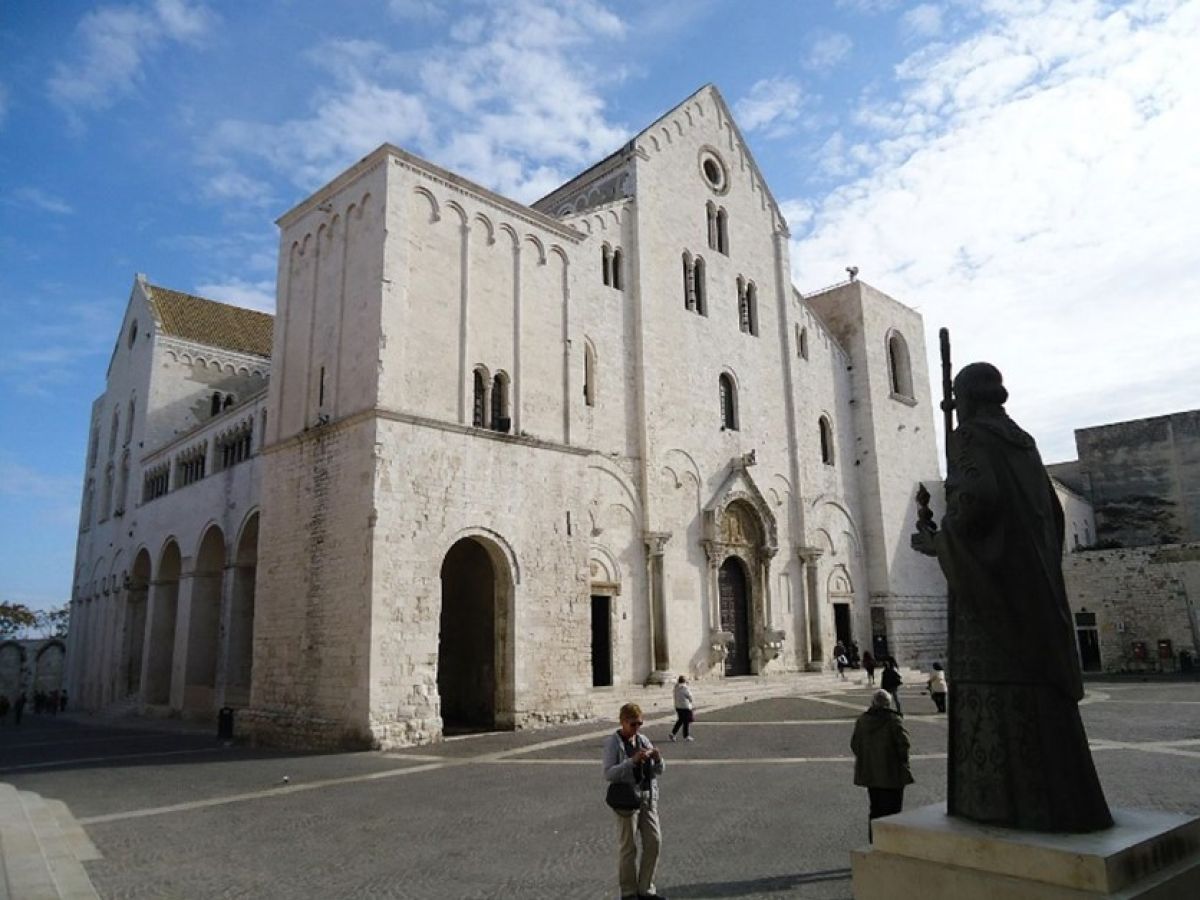1 WEEK IN PUGLIA
PRIVATE TOUR
Matera, the perfect movie set, Alberobello and its fantastic houses, and Salento with Lecce, the Florence of the South.
At the discovery of green Puglia, with its transparent seas and exceptional food!
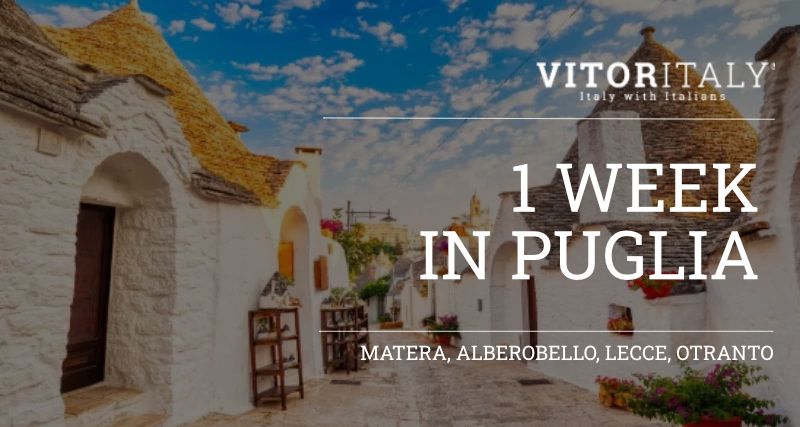
HIGHLIGHTS
- Locorotondo and Martina Franca, the white cities
- Polignano a Mare, the world’s most welcoming resort
- Alberobello, living in Trulliland
- Matera, the city of stones
- Lecce, the “Florence of the South”
- Otranto, crossroad of civilizations
WHAT’S INCLUDED
Overnights at 3* to 5* Hotels, Country Houses, Typical Masserie and Historical Palaces (when available), City Apartments along the itinerary
Transfers by private car / minivan / minibus
Activities:
- Day 1: Full-day excursion to Locorotondo and Polignano a Mare
- Day 2: Full-day excursion to Martina Franca – Mozzarella and Burrata making class in an ancient Masseria
- Day 3: Full-day excursion to Matera and Alberobello – 3-hour private walking tour of Matera city centre with an Authorised Tourist Guide – Admission to Church and cave House
- Day 4: Pugliese Cooking Class in a typical Trullo
- Day 5: Full-day excursion to Lecce – 3-hour private walking tour of Lecce city centre with an Authorised Tourist Guide – Visit of a local wine cellar with tastings
- Day 6: Full-day excursion to Otranto
- Day 7: 2-hour private walking tour of Bari city centre with an Authorised Tourist Guide
Customizations and Options:
- Pick up at Bari Airport / Bari Railway Station at the start of the tour
- Accommodation in Martina Franca area the night before the start of the tour
- Visit of a local olive oil mill with tastings in Otranto area
- Drop off at Bari Airport / Bari Railway Station at the end of the tour
- Other options upon request
Benvenuti in Italia, and Welcome to Puglia!
Locorotondo is nestled in the Itria valley, and its evocative name anticipates its conformation. From the various vantage points, you can enjoy the typical rural landscape characterised by “casedde”, masserie and small trulli. In the historical centre, organised with concentric lanes, the low houses with pointed roofs and whitewashed walls (the “cummerse”, initially to fight the sun and the plague) have become, over time, the very symbol of the village. Entering through the Porta Napoli gate, between open spaces and houses, you come to Palazzo Comunale (early 18th century) and Palazzo Morelli, with elegant Baroque balconies. The heart of the village is the Church of S. Giorgio, dating back to the late 18th century, while the Church of Santa Maria la Greca is of Roman-Gothic inspiration and features a splendid rose window.
White and perched on a cliff overlooking a dreamy inlet, Polignano a Mare is one of the most beautiful Apulian villages overlooking the Adriatic Sea, offering emotions with every visit.
The 11th edition of the Traveller Review Awards 2023, compiled by Booking.com, named Polignano a Mare the “world’s most welcoming resort” for 2023. The ranking is based on 240 million verified reviews left by customers on the site and rewards the natural and cultural heritage of localities and territories, food and wine and local traditions, as well as the facilities and services provided to welcome tourists and travellers.
This Apulian city is the birthplace of Domenico Modugno, a legendary author and the singer of Volare, one of the most popular Italian songs in the world. Here, you will wonder at the town’s many panoramic views, which dominate that stretch of coastline from above.

Martina Franca is a charming baroque town 400 metres above sea level. The era of greatest splendour for this city was undoubtedly the 18th century when the most important monuments and churches still dominating the historic centre were built. Baroque is the predominant style; it can be seen in many buildings, and in this city, it has taken on characteristic connotations that distinguish it from the other variations of this artistic and architectural current; in fact, we speak of “Martinese” Baroque.
The city centre is characterized by a labyrinth of narrow streets and narrow cobbled streets, surrounded by houses that develop mainly vertically; in the past, shops were on the ground floor, while the first and second floors were used for family life. Saint Martin’s Basilica in Piazza del Plebiscito, the city’s central square, features a majestic façade featuring the image of St. Martin (the town’s Patron Saint) while sharing his cloak with a beggar. The interior boasts paintings of great value by Domenico Antonio Carella and a high altar in polychrome marble of the 18th century. The church also houses the relics of Santa Comasia and Santa Martina.
Locorotondo is nestled in the Itria valley, and its evocative name anticipates its conformation. From the various vantage points, you can enjoy the typical rural landscape characterised by “casedde”, masserie and small trulli. In the historical centre, organised with concentric lanes, the low houses with pointed roofs and whitewashed walls (the “cummerse”, initially to fight the sun and the plague) have become, over time, the very symbol of the village. Entering through the Porta Napoli gate, between open spaces and houses, you come to Palazzo Comunale (early 18th century) and Palazzo Morelli, with elegant Baroque balconies. The heart of the village is the Church of S. Giorgio, dating back to the late 18th century, while the Church of Santa Maria la Greca is of Roman-Gothic inspiration and features a splendid rose window.
Puglia is the land of Burrata, a unique, creamy variety of Mozzarella. At a local dairy farm in the area, under the guidance of an expert dairyman, you will enjoy making fresh mozzarella and creamy burrata in a traditional, homemade way. You’ll learn about the cheese-making process and try making this typical Apulian tasty food with your hands! And, at the end of the visit, a delicious tasting awaits you, with a rich selection of fresh milk products, local cold cuts and baked goods, and a glass of Apulian wine.
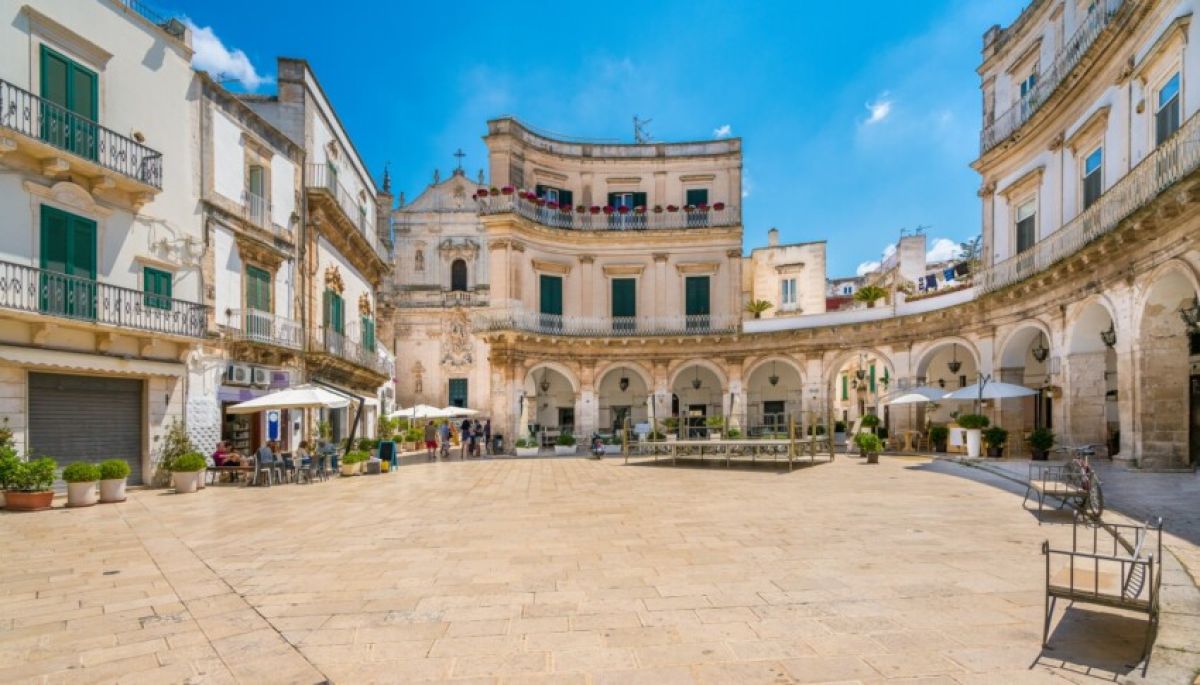
Matera is one of the oldest cities in the world, whose territory holds evidence of human settlements starting from the Paleolithic and without interruption until today. Touring Matera is like experiencing a forgotten past – you feel like setting foot in a nativity scene when you visit this charming city in Lucania. It’s no coincidence it’s referred to as “the second Bethlehem” and was the setting for Mel Gibson’s movie “The Passion” and the last James Bond, “No time to die”.
Matera is widely known as the city of the “Sassi”, the original urban nucleus, developed from the natural caves carved into the rock and subsequently modelled in increasingly complex structures.
In the 1950s, when the inhabitants who lived in the caves dug out of the mountain were forced to abandon those dwellings to settle in modern districts, no one would have ever thought that those grottos – the Sassi – would have become the symbol of a reborn city. UNESCO added the Sassi of Matera to its list of World Heritage Sites in 1993 as a whole and a millennial way of life to be preserved and handed down to our descendants. In fact, it was recognized as a model for living harmoniously with the environment while integrating with it and taking advantage of resources without disturbing the environment.
Geologists call it calcarenite, and ordinary folk refer to it as “tuff”: it’s the rock surrounding Matera that this land’s master artisans learned to work with in ancient times. This brittle, adaptable material is abundant in the mountain that dominates the city, so it seemed only natural for the people from Matera to go up there and dig out that rock to build a home. The extracted material was processed to make the façade of the dwelling. After the first home, others were constructed until the network of houses, tunnels and alleyways became that magical place called Sassi – a gigantic sculpture, a miracle of town planning!
In Matera, you’ll discover one of the most beloved Italian breads. Pane di Matera is a bakery product for which only hard wheat semolina and sourdough are used. The characteristics to recognize the bread of Matera are the shapes, croissant or high bread, and a straw-yellow crumb. But besides bread, you’ll not miss other local specialities such as the Caciocavallo cheese or the Lucanica sausage.
The Trulli are famous worldwide for their beauty and unique characteristics and represent one of the most extraordinary examples of Italian folk architecture. They were built in a particular historical period when the construction of stable dwellings was highly taxed; the region’s inhabitants thus boasted a great capacity to adapt and an exceptional cleverness in coming up with the Trulli, temporary houses built with the local stone. From precariousness to stability – the process of transformation and recovery and the deference to the originality of the work earned the Trulli of Alberobello their recognition as a World Heritage Site.
In Alberobello, the capital of the Trulli, each Trullo has a different shape and size. Unique constructions are sometimes combined in a complex of communicating houses, while others are built on two levels. Most feature a grey cone-shaped roof, ending with a sphere or hemisphere shape. The interior, arranged as a single chamber, comprises niches for a fireplace, bed and furniture. The structure assures excellent indoor climate control: cool in summer and warm in winter!
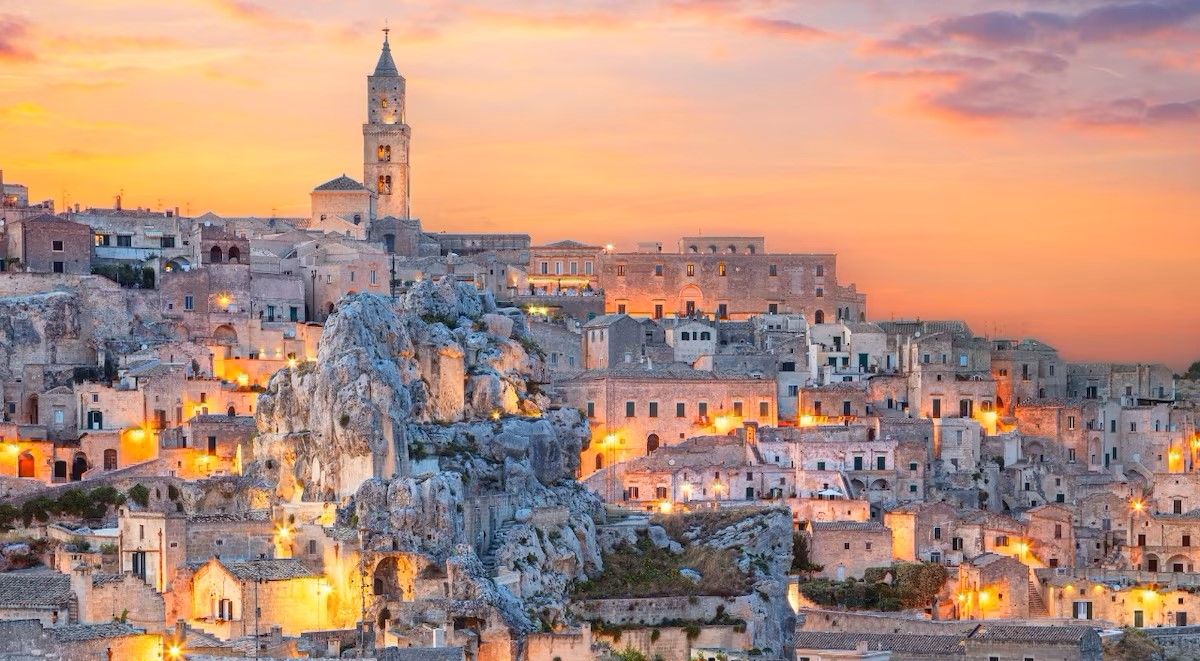
The region’s geographical location more characterizes Pugliese cuisine than any other Southern Italian gastronomic tradition. Over the centuries, Puglia has been a crossroads of peoples with very different cultures that have contaminated many aspects of everyday life, and therefore also food, with cooking methods, ingredients and customs, giving life to natural mixtures of flavours and smells that still delight the palates of locals and visitors. Pugliese cuisine is characterized above all by vegetables, the real foundation of the traditional diet of this area: turnip top, green cabbage, thistle, peppers, eggplants, artichokes; all legumes, from beans to chickpeas, peas and fava beans, fresh in spring and dry in winter. Fish is excellent, especially in areas close to the coast: bluefish dominate, but molluscs and crustaceans are also common. But the real king of Salentine cuisine is bread, made from unrefined wheat flour, with a particularly dark colour due to bran.
You will learn the most popular recipes of the Apulian tradition in a tasty “Pugliese” cooking class: here, you will have the opportunity to make Orecchiette and indulge in homemade Focaccia and bread, Tarallini, vegetables, cheeses and cured meats carefully chosen to ensure maximum flavour (to know more about Pugliese cuisine read “In Puglia, eat like a Pugliese” in our BLOG).
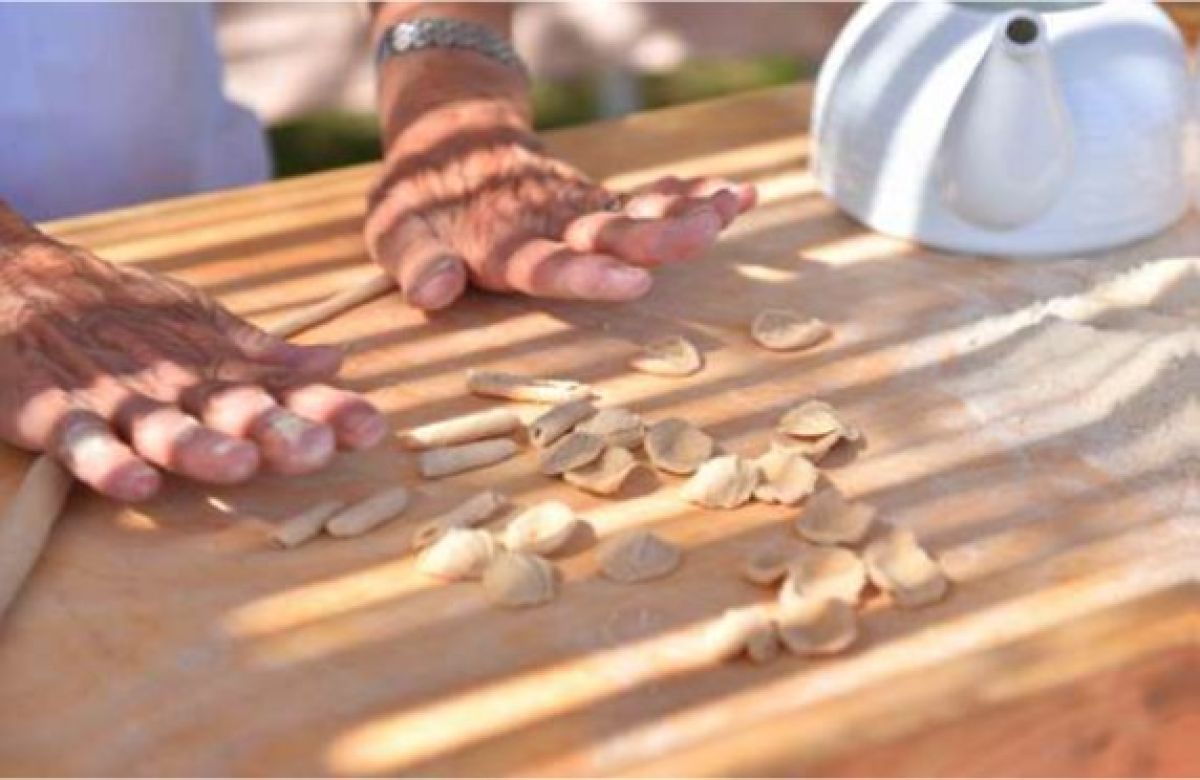
Lying on a plain at the foot of the Salento Plateau is Lecce – the “Florence of the South” – one of the most exciting cities in the region for its architecture, typical of the 17th century.
Of ancient origins, the city experienced two distinct periods of prosperity: the Roman era and the Kingdom of Naples. Under both, the construction of buildings, monuments and mansions increased heavily. These new structures were characterized by magnificent and rich ornamentations that earned this typical architecture the definition of “Leccese Baroque”. The imaginative and meticulous sculpting work was facilitated by the fact that the local stone is flexible and easy to inlay. A visit to Lecce can begin with Piazza Duomo, once used as a fortress and today considered the most elegant “salon” in the city. The grandeur of the Duomo, the work of Zimbalo, Cino and Penna, the five-story-tall bell tower, the Palazzo Vescovile (Bishop’s Palace), and the Palazzo del Seminario (Seminary) mark the perimeter of the square, one of the monumental works that best represent the magnificence of Lecce’s style.
Not far away, Piazza Sant’Oronzo narrates the city’s entire history. The Roman period is visible in the ruins of the Amphitheatre that becomes the exceptional stage for theatrical performances in the summertime, and in part by the high Column – on which stands a bronze of St. Orontius, depicted in the act of blessing – erected in the 17th Century utilizing some of the Roman columns positioned on the Ancient Appian Way. Palazzo del Seggio, known as the “Seat,” hosting important art exhibitions, and the Church of Santa Maria delle Grazie, with its interesting frescoes and works sculpted in wood, are the very symbols of the Apulian Renaissance.
Not to be missed is a visit to the Basilica di Santa Croce, where the inspiration of master masonry is visible in every part of the monumental façade that anticipates the beauty of its interior, a harmonious balance between the sobriety of the classical style and the splendour of Lecce’s Baroque.
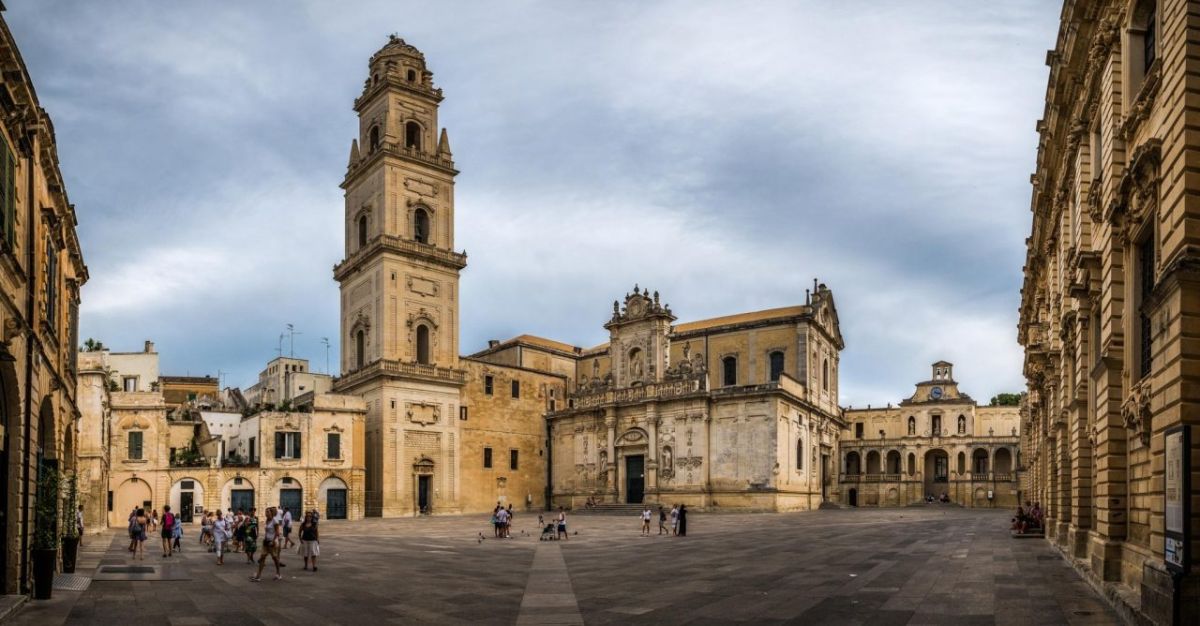
Southern Puglia, also called “Salento”, is actually ‘a region inside the region’. It is the area with most municipalities in Italy, almost all consisting of small or tiny villages, each jealous of its patronal feast, dialect and typical products.
Walking in the oldest part of Otranto, enclosed by the Aragonese walls, you will enjoy its millennial charm, with the white houses and the maze of streets paved with stones that converge towards the Romanesque Cathedral, characterized by the imposing Renaissance rose window. Inside, you will discover the precious mosaic floor made in the 12th century by the monk Pantaleone, depicting the Tree of Life with scenes that mix sacred and profane. Then, the Castle was built by Alfonso of Aragon at the end of the 15th century, in close relationship with the city walls, which is the background to art exhibitions and events.
Gallipoli, meaning “Beautiful City” in ancient Greek, sits on the Ionian coast like a mirage. Perched on an island of limestone origin, the old village is connected to the mainland and the new city by an arched bridge of the 20th century, recently flanked by another bridge towards the port. Today, the walls, bastions, and towers that once protected the city from invaders shelter it from storms, giving it the charm of the past. The Angiò fortress, surrounded almost entirely by the sea, is accessible from the old city: here, you will immerse yourself in history through towers, tunnels, corridors and majestic halls.
You will discover unique colours and scents in the countryside, a bit acrid and spicy. Follow the road from Otranto to Santa Maria di Leuca: here, the Mediterranean scrub meets the sea on a steep hilly coast of rare beauty for a once-in-a-lifetime scenery that will rest forever in your heart.
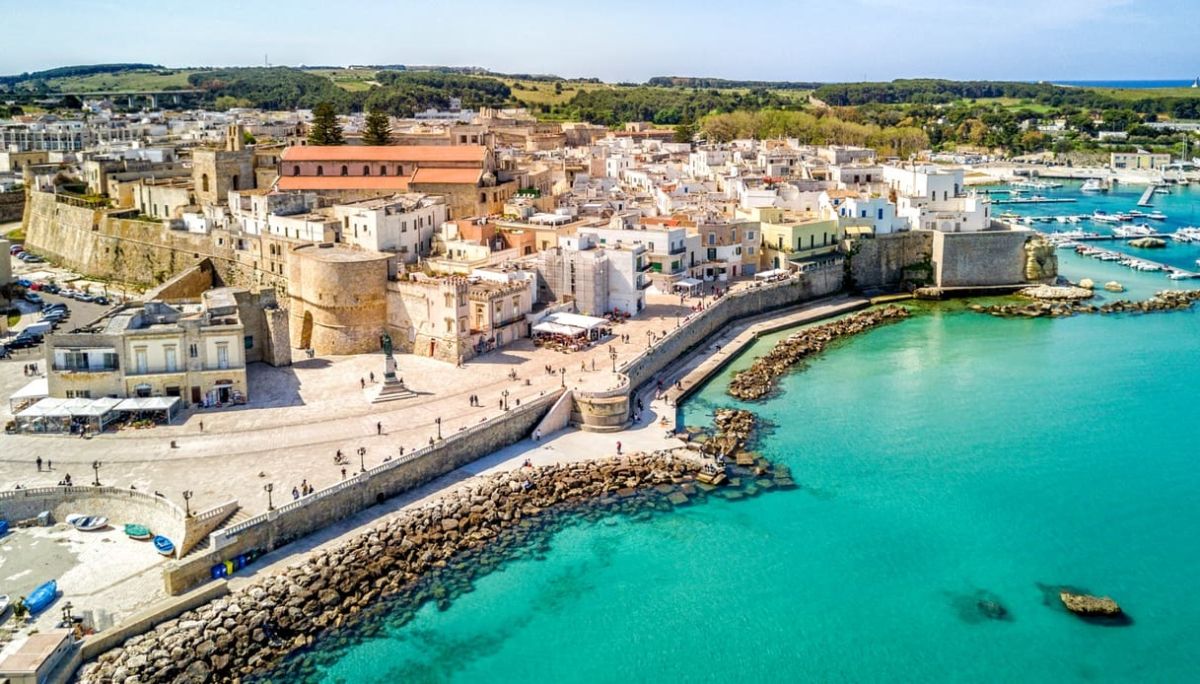
Bari, an important religious and commercial centre defined as “the door to the East“, presents a significant ancient town centre in terms of historical and urban heritage. The city’s mild climate makes it a top-rated destination, with many tourist and cultural attractions and numerous beaches.
The city has ancient origins and takes its name from the Greek Barion; it was a Roman municipality taken over in later times by Byzantines and Swabians, which became the heart of Italian Orthodox Catholicism and a place of pilgrimage for the three monotheistic religions during the Middle Ages. One of its many symbols is, in fact, Basilica di San Nicola (St. Nicholas), which was erected in the heart of the old city in Romanesque style towards the end of 1200 to house the relics of St. Nicholas, which according to tradition, were stolen by devout sailors from the city of Myra (now Turkey) and brought to Bari in 1087.
Another Romanesque building showing a majestic rose window is the Cathedral of San Sabino. In contrast, different styles characterize the following impressive buildings: the Palace of the Apulian aqueduct, Palazzo Mincuzzi, both in an eclectic style, Palazzo Fizzarotti, whose three floors are in Venetian style, and the 19th-century neoclassical Palazzo de Gemmis.
The coast around Bari is dotted with several medieval towers built for defensive purposes against the Saracen pirates. However, the most important defensive construction is still that of the Norman-Swabian castle and its long wall surrounding the old city, which dates back to the twelfth century.
Evenings are given over to strolling along the promenade in the mild climate, followed by a visit to one of the many restaurants in the city centre offering local dishes of raw fish and “poor” cuisine centred on “orecchiette” pasta. Alternatively, try one of the many places offering a typical aperitif accompanied by “tarallucci” (savoury round pretzels) and “friselle” (a ring-shaped hard bread that requires dipping in water).
The tour is over, but the memories of a fantastic journey will accompany you for a lifetime!
See more about your destinations on our YouTube channel.
Arrivederci for another tour with VITOR, Visit Italy on the Road.
